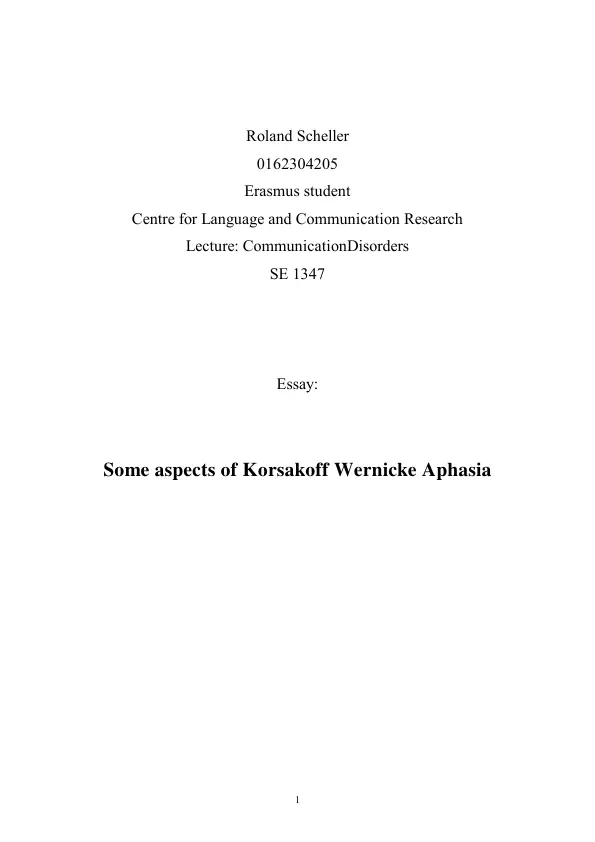Linguistics is a wide field. It consists not only of the analysis of the speech of healthy people and people that run through the educational system without any complications. One very important part of linguistics and communication studies is the analysis of communication disorders. But it might be assumed that people with communication disorders are only a small minority. But that is not true. In the UK there are for example more than four million illiterates. There are phenomena like autism or Alzheimer’s disease, a dementia. But some people suffer from aphasia and amnesia.
There is motor aphasia (e.g. Broca’s aphasia), sensory aphasia (e.g. Wernicke’s aphasia) and global aphasia. In this essay I will describe the so-called Korsakoff Wernicke aphasia (KWA), which is an aphasia combined with different types of amnesia. Amnesia is a memory disorder and this essay suggests that memory disorders have consequences for human communication and must therefore be also regarded as communication disorders. I will describe the characteristics of Korsakoff Wernicke aphasia, locate it in a diagram, mention some test methods for its appeal and cite case studies. Furthermore I will illustrate the memory defect with a memory model. Korsakoff’s syndrome is severe amnesia that is the result of strong alcohol abuse. Korsakoff’s syndrome is defined as “Korsakoff’s syndrome (Korsakoff’s psychosis): an organic disorder affecting the brain that results in a memory defect in which new information fails to be learnt although events from the past are still recalled, disorientation for time and place; and a tendency to invent material to fill memory blanks (see confabulation). The commonest cause for the condition is alcoholism, especially when this has led to deficiency of thiamin (vitamin B1). Large doses of thiamin are given as treatment. The condition often becomes chronic.[S.S. Korsakoff (1854-1900), Russian neurologist]”(Oxford Concise Colour Medical Dictionary, 1998).
Inhaltsverzeichnis (Table of Contents)
- Some aspects of Korsakoff Wernicke Aphasia
- Korsakoff's syndrome
- Wernicke's Encephalopathy
- Types of amnesia
- Brain damage in KWA patients
- Broca's area
- Wernicke's area
- Test-methods
Zielsetzung und Themenschwerpunkte (Objectives and Key Themes)
This essay aims to provide a detailed description of Korsakoff Wernicke Aphasia (KWA), a communication disorder characterized by aphasia and amnesia. It explores the nature of KWA, its characteristics, its relationship to alcohol abuse, and the impact of memory disorders on communication. The essay will also delve into the specific brain regions involved in KWA and examine relevant test methods for its diagnosis.
- The characteristics and causes of Korsakoff Wernicke Aphasia
- The connection between alcohol abuse and KWA
- The impact of memory disorders on communication
- The role of specific brain regions in KWA
- Test methods for diagnosing KWA
Zusammenfassung der Kapitel (Chapter Summaries)
The essay begins by defining Korsakoff's syndrome and Wernicke's Encephalopathy, both of which are linked to alcohol abuse and vitamin B1 deficiency. It then discusses different types of amnesia, including post-traumatic amnesia, retrograde amnesia, and anterograde amnesia, highlighting the role of alcohol abuse in causing severe anterograde and retrograde amnesia in KWA patients. The essay further explores the brain damage associated with KWA, emphasizing the impact of alcohol abuse on specific brain areas, such as the dorsomedial nucleus.
The essay then delves into the language areas of the brain, focusing on Broca's area, responsible for speech planning and production, and Wernicke's area, responsible for speech comprehension. It explains how impairments in these areas contribute to different types of aphasia and how the symptoms of KWA, particularly egocentric repetitions, can be attributed to memory impairments. The essay concludes by outlining various test methods for diagnosing KWA, including the Peterson short-term memory task, the Wisconsin card sort test, and the WAIS test. It also discusses specific tests for anterograde and retrograde amnesia.
Schlüsselwörter (Keywords)
Korsakoff Wernicke Aphasia, amnesia, alcohol abuse, communication disorders, Broca's area, Wernicke's area, brain damage, memory impairment, test methods, diagnosis, language areas, speech production, speech comprehension.
- Citar trabajo
- Dr. phil. Roland Scheller (Autor), 2000, Some aspects of Korsakof-Wernicke aphasia, Múnich, GRIN Verlag, https://www.grin.com/document/111418



